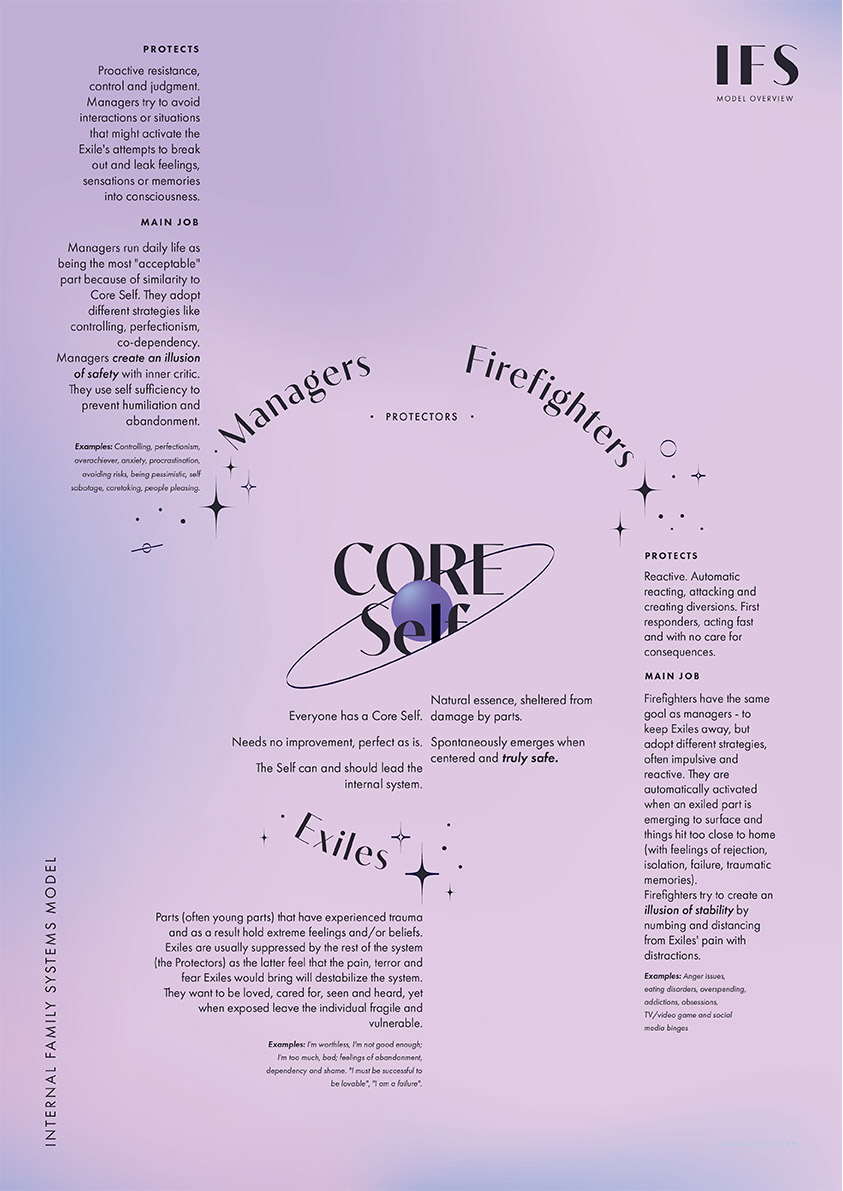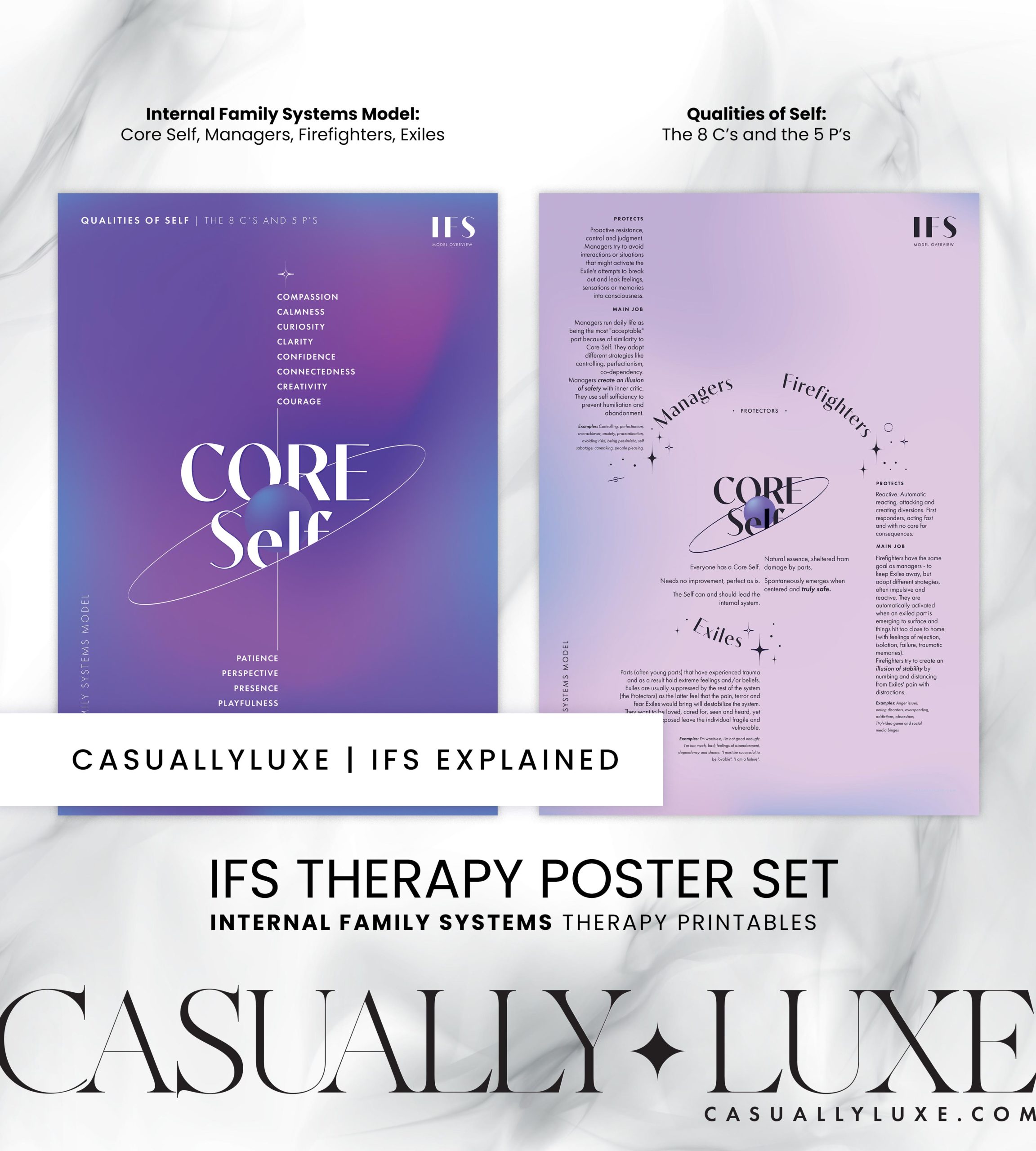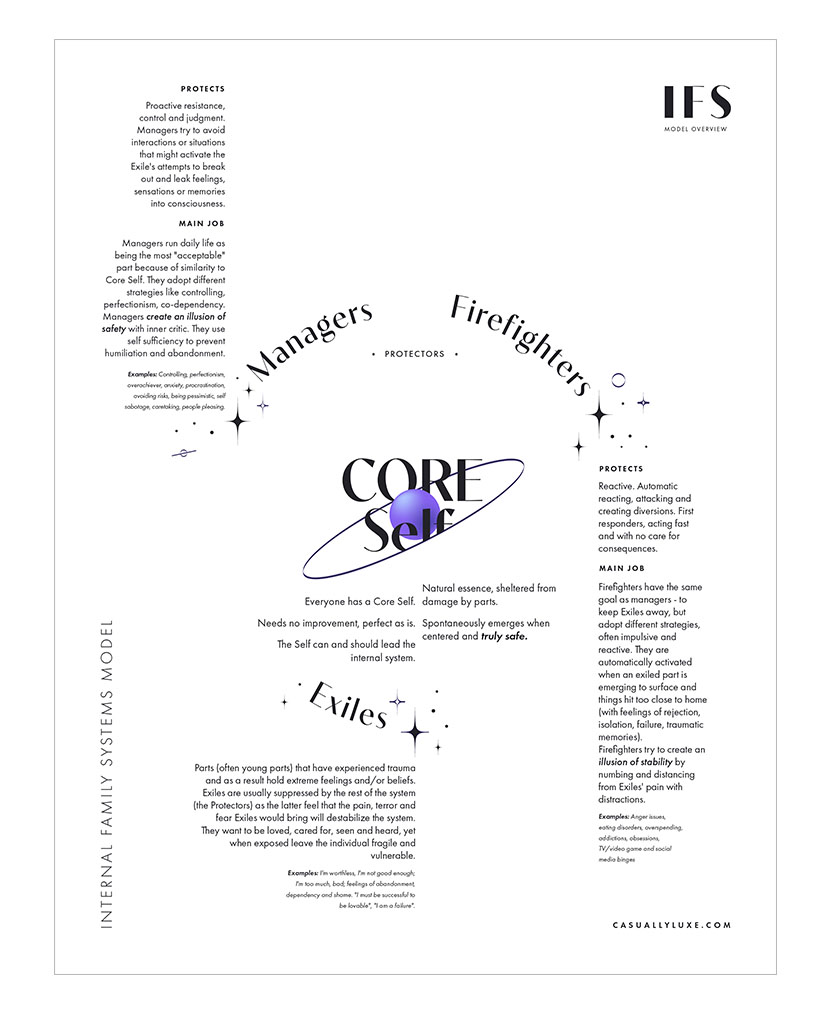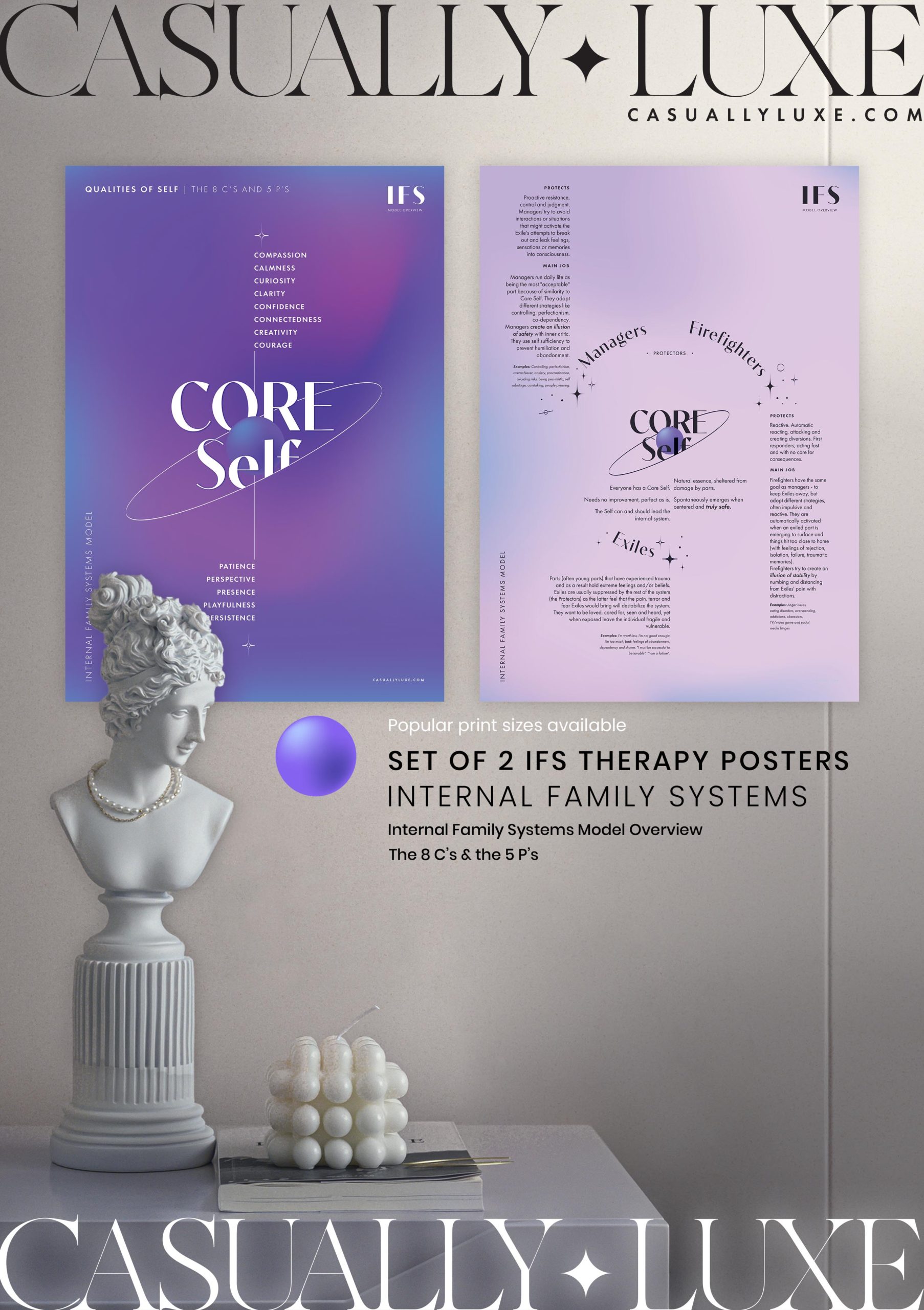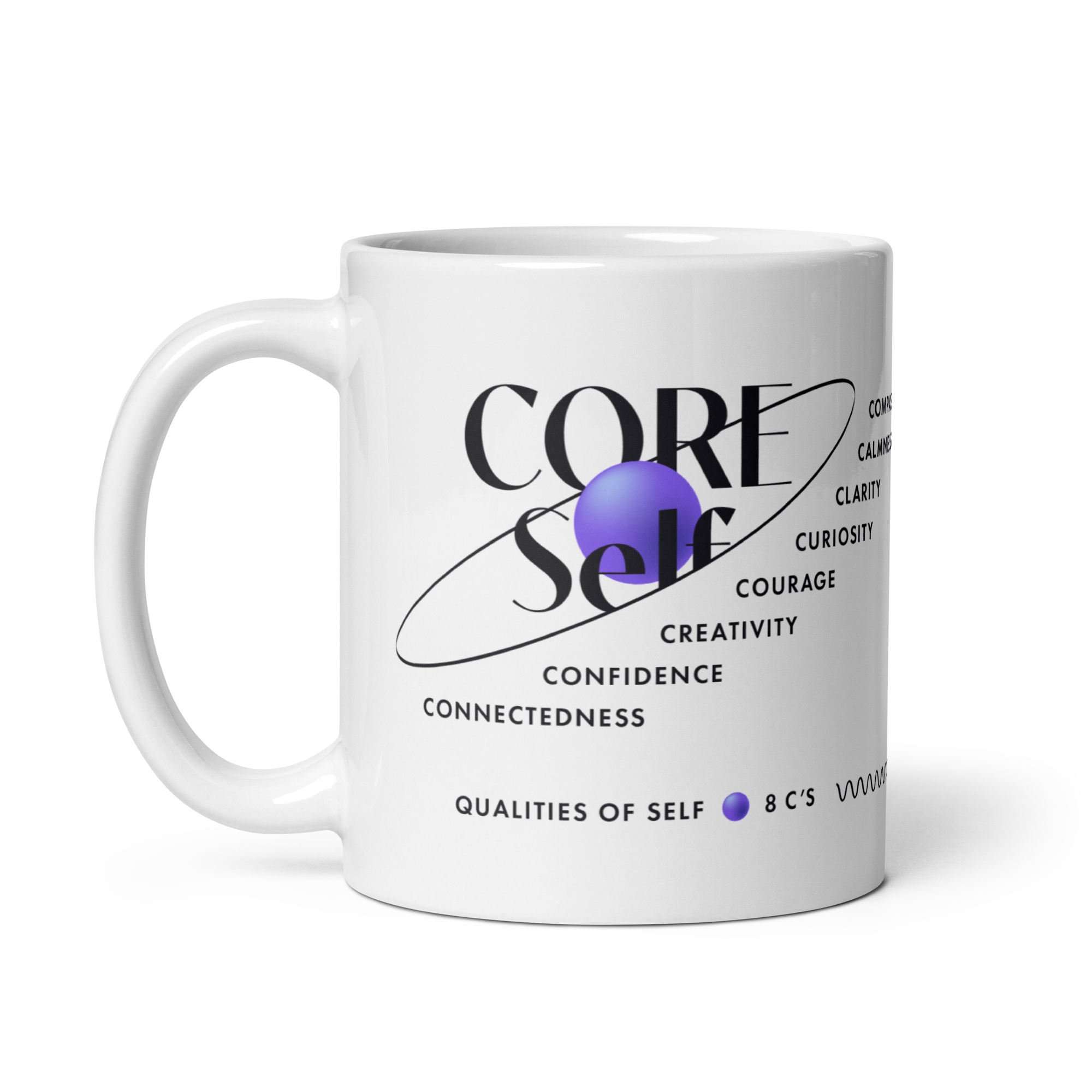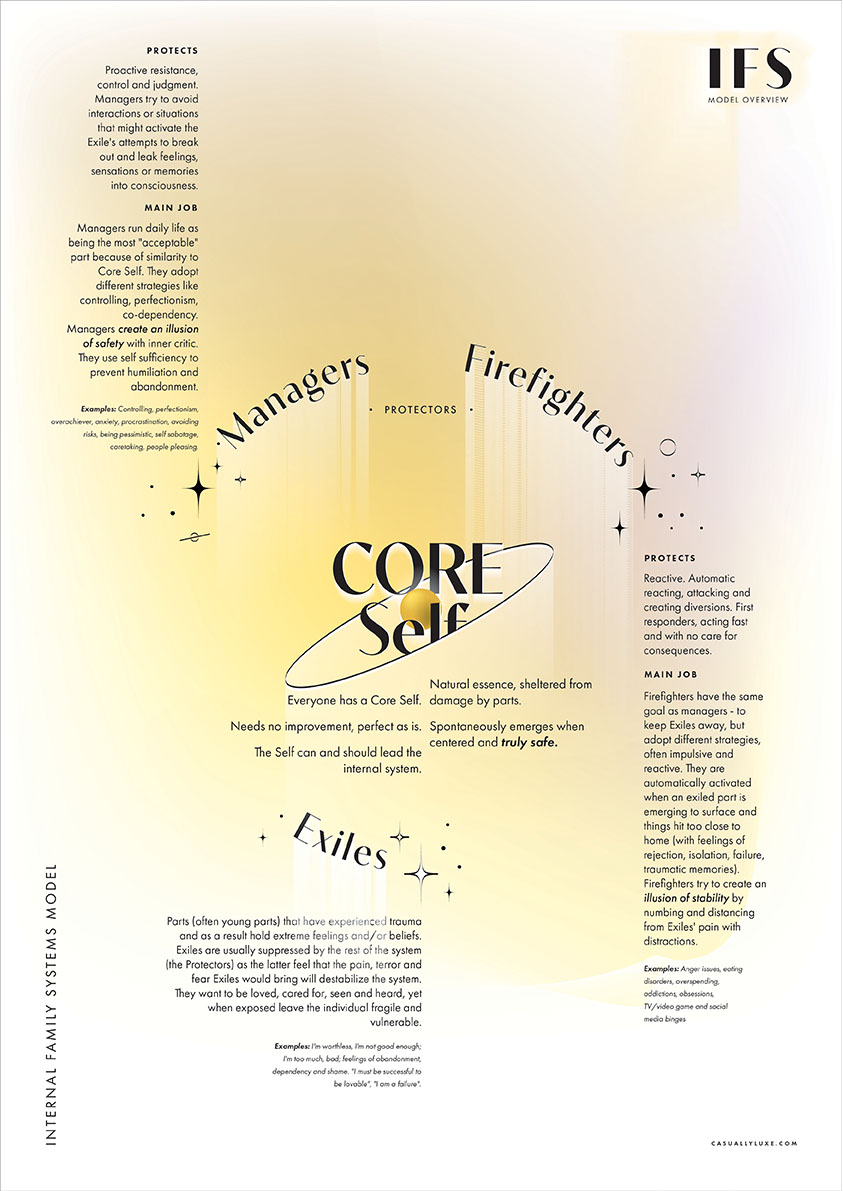IFS Therapy Explained
What is Internal Family Systems Therapy, With Infographics
Internal Family Systems (IFS therapy) is an approach to psychotherapy that identifies and addresses multiple sub-personalities (“Parts“) within a person’s psychological makeup. Therapist Richard C. Schwartz, PhD, first conceptualized the model in the 80’s.
Schwartz combined his knowledge in Family Systems Therapy with his findings during his practice, in particular working with anorexic patients. He created a model where systems thinking is combined with multiplicity of the mind – the idea that the mind is comprised of discrete sub-personalties.
Therapy of The Internal Family System
In the IFS model, these sub-personalities, called managers, firefighters and exiles, together with the Core Self represent a “family”, hence the “Family” part in IFS therapy. According to Richard C. Schwartz, these subpersonalities each possess their own unique perspectives and attitudes, which can often differ significantly from one another.
Consequently, the whole system of the psyche can be a subject to a family therapy of sorts, where each subpersonality is given a space to express themselves and be heard.
Managers, Firefighters and Exiles
IFS therapy’s categorizes the subpersonalities, or Parts, in three groups – Managers, Firefighters and Exiles:
- Managers comprise our overall personalities and how we operate in the world. They can be controlling and generally want us to put up our best face to the outside world. The so-called Inner Critic is a typical representation, as well as a persona within us that pushes us into perfectionism.
- Firefighters come up when unforseen events or emotional disturbances makes past trauma resurface. This is when an Exile, a supressed emotion from a past event, is triggered. Firefighters act impulsively and can do a lot of damage (think drug, alcohol and food abuse, anger issues, etc.).
- Exiles are essentially the parts of us that have been injured and hide in exile. In other words, that is the unresolved trauma we have stored in our bodies and minds. Overall the job of both Managers and Firefighters revolves around guarding Exiles from resurfacing, because they, as Protectors, believe it’s what’s best for us.
Managers and the Firefighters are collectively called Protectors, as their main job is to guard the persona from the emergence of an Exile.
The Core Self and Its 8 C’s and 5 P’s
Another key component of the IFS model is the theory behind the Core Self. Internal Family Systems states that each person’s psyche, while comprised of different subpersonalities, has a Self within that is the true, central self, and is inherently good and whole.
Basically, during therapy the Self emerges beneath individual Parts’ opinions, emotions and beliefs.
The Self posesses essential zen-like qualities that make it distinct from other Parts – the 8 C’s and 5 P’s:
8 Cs:
- Confidence
- Calmness
- Creativity
- Clarity
- Curiosity
- Courage
- Compassion
- Connectedness
5 Ps:
- Presence
- Patience
- Perspective
- Persistence
- Playfulness
The 8 C’s and 5 P’s of the Core Self Illustration
The concept of the Core Self is somewhat controversial for some people. Some critics point out that there is limited empirical research to support the existence of a unified, inherently positive Core Self. The idea is seen as more theoretical or philosophical rather than evidence-based.
How Does IFS Therapy Work
IFS therapy helps to understand the different components of our psyche and then heal past trauma through establishing a balance between inner contradictions. This happens through conversations between the therapist and the patient, where feelings of Parts are aknowledged and understood with compassion.
The process involves employing both the core Self and the therapist as facilitators in talking with Parts. Essentially, the IFS therapist becomes a facilitator of the conversation between the Self and Parts.
IFS Therapy & Healing With Compassion
A core principle of IFS therapy is indeed the idea of healing trauma and pain with compassion. The therapist helps the client to understand each part’s positive intentions, even if their actions are counterproductive or harmful.
As it’s said, there’s no bad parts, and also – each part’s intentions, much like in Shadow Work, comes from the goal to be safe and free from harm.
Unburdening of Exiles
Internal Family Systems has another typically used terminology – unburdening of parts. IFS therapy seeks to heal and unburden the exiled parts by releasing the pain, fear, or limiting beliefs they carry. This is often done by revisiting past traumas or painful memories in a safe and controlled environment.
Restoring Confidence in the Self
In IFS, a key goal is to strengthen the leadership of the Core Self. Being self-led (time to mention my Self-Led mug) means leading from the core Self and functioning with greater clarity, agency and calmness in the world.
IFS practitioners report “being in Self” as feeling the essence of those quality, and from that viewpoint being able to make better decisions about their inner issues. The Self is crucial in IFS therapy as it is believed to be capable of healing and harmonizing the various parts.
The Six F’s In IFS Therapy
To connect with parts, unburden exiles and reestablish relationship with the Self, IFS uses the process of the six F’s (psychotherapy is big on abbreviations).
The 6 Fs is a process usually practiced with the help of a therapist as a facilitator:
- Find: Identify a Part that needs attention.
- Focus: Pay attention to the Part.
- Flesh Out: Describe the Part and how it feels.
- Feel: Explore feelings toward this Part.
- BeFriend: Show curiosity and acceptance towards the Part.
- Fear: Ask about the fears and concerns of the Part. What it would fear if its role changed?
In the process of helping clients being self-led, therapists can benefit from using my IFS therapy posters – either this one, or the printable versions.
Can You Do IFS Therapy by Yourself?
Feeling Parts in the Body
Even though in Internal Family Systems it is strongly recommended working with a therapist, you can do some of the exercises yourself. Exercises involve mindfulness and self-imposed questions, where you try to feel certain aspects of the Part you want to work with.
As an aid for your personal exploration, you can use my printable IFS therapy explained infographics. You can also order an IFS therapy poster.
IFS Therapy Exercise Practiced on Your Own
An example IFS exercise you do by yourself would be:
- Find: Identify a Part. Notice thoughts, emotions, or physical sensations that might indicate a Part needing attention.
- Focus: Concentrate on this Part. Quiet your mind and turn your internal gaze towards this Part.
- Flesh Out: Understand the Part. Ask yourself what you know about this Part, its role, and its protective intentions.
- Feel: Recognize your feelings toward this Part. Are you angry at it? Scared of it? Try to just notice these feelings without judgment.
- BeFriend: Build a relationship with this Part. Show it compassion and curiosity instead of hostility or fear.
- Fear: Inquire about the Part’s fears. Ask what it’s afraid of and what it thinks might happen if it stops doing its job.
In theory, doing this exercise should be done from the position of calmness, curiosity, compassion, and clarity – that is, being self-led.
Self-led IFS requires a gentle, non-judgmental attitude and a willingness to explore and accept your Parts. It’s important to be patient and kind during this process of self-inquiry.
Who is IFS therapy For
Internal Family Systems can be very effective for anyone who seeks to understand themselves better, especially understand patterns of self-sabotage and polarizing feelings. IFS therapy can help for any of life’s usual challenges – from relationship problems to career issues.
However, besides achieving inner peace, IFS therapy is also suitable for healing trauma and for various cases like depression and anxiety, eating disorders, substance abuse and attachment issues, to name a few.
To heal these various inner issues, IFS employs various techniques like self-compassion, compassionate communication, inner child work, and mindfulness.
IFS Therapy for Healing Trauma and Cptsd
IFS is highly effective in treating trauma, including complex trauma and PTSD. It helps with accessing and healing parts that are stuck in traumatic experiences.
According to IFS, traumatic unjuries reorient a person’s internal family. Thus, some parts are traumatised, while others adopt protective roles.
Because parts with trauma are deeply hurt, the rest of the family doesn’t want to talk with them anymore. Those parts get into an exile, while the rest of the family tries to keep face and deal with the world. Of course, as it’s with life, things happen and those parts’ trauma surfaces to the person’s mind. This is where the problems usually start.
A Gentle Approach to Trauma Therapy
Trauma therapy in IFS is about a gentle advancement to get the parts wounds and trauma to talk. However, that can’t happen until the protective parts are pursued to trust the self.
This is what makes IFS (trauma) therapy so unique and useful. It is the idea that you have to be gentle and understanding of different sides of your personality, if you want to have lasting, or any effect in trauma therapy at all.
Trauma As a Learned Response
As we all know from trauma therapy, a trauma response was once adaptive and served a purpose. A now maladaptive reaction, then it was the right thing for the unique conditions, especially as a child.
So a core idea in IFS therapy is that “there are no bad parts”. Even very destructive parts have their own reasoning of why they do it – they truly believe that it is for the whole’s good.
For Self-Esteem
Internal Family Systems therapy can be very effective for self-esteem and self-image issues. The therapy assists in uncovering and healing parts that carry negative beliefs about the self.
IFS Therapy for Eating Disorders
As I mentioned, Dr. Richard Schwartz, the founder of the IFS model, initially encountered what would be the birth of the model in patients with bulimia. While treating these patients, he discovered that many of them described experiencing various parts within themselves. These parts often had conflicting goals and emotions, which played a significant role in their eating disorder behaviors.
Dr. Schwartz observed that these internal parts seemed to be in conflict with each other. Some parts were trying to protect the individual in ways that were unfortunately counterproductive or harmful, such as through disordered eating behaviors. Other parts carried burdens of emotional pain, trauma, or harmful beliefs about the self.
With eating disorders such as anorexia and bulimia, an extreme polarity in the person’s mind creates these harfmful actions carried by different parts. IFS emphasizes understanding and respecting the intentions of each part, and it identifies the presence of a Core Self that is inherently compassionate and wise.
IFS Therapy & Shadow Work
IFS therapy’s main goal is integrating subpersonalities, often in conflict with each other. In this way, Internal Family Systems’ ideas are very similar to the goal of the Jungian’s Shadow work and integrating the complexes.
Similar to Shadow work, with IFS therapy we’re asked to recognize and integrateg unconscious aspect of our personalities. However, what differentiates IFS therapy is that it recongizes a separate entity in our psyche, the Core Self.
IFS Therapy Model Example
A simple example of the IFS therapy model in a person’s psyche, where a person is copying with the effects of a hidden trauma. would be the following:
- Their Manager part is an aspect of their persona that stimulates them go to work, take care of the person’s finances, achieve work goals etc. In short – Managers run the person’s life. The Manager can also be a furious Inner Critic type-of-inner-voice, and be overly critical if goals aren’t met according to their standards.
- A Firefighter part is an aspect of their persona which emerges when the person is stressed and overwhelmed, and when the Exile (the hidden trauma) is close to surface. In case that there’s stress resembling past trauma that triggers the Exile, the Firefighter would emerge. Firefighters are explosive, impulsive, and would make the person engage in copying mechanisms such as overeating, for example.
- The Exile is the hidden part of the psyche, unresolved trauma that often stimulates the person to self-sabotage and go against their goals. Exiles emerge in the form of feelings, sensations and memories of pain, uneasiness etc. Unless the trauma is healed through IFS therapy or another therapeutic modality, it sits in the subconscious and emerges whenever there’s a trigger.
The Core Self and Its Zen-Like Qualities
A prominent feature of IFS therapy is the idea that each of us has a Core Self, an innate part of us that is not a Part, but actually who we are.
The Self is beneath all sub-personalities and has zen-like qualities such as the 8 C’s and 5 P’s of the Self.
IFS Parts, Explained
In IFS Parts resemble small personalities that are contained within our psyche. IFS parts are in essence subpersonalities that, if non-extreme, bring is joy, awe, curiosity and spice up our behavior and view of the world
Parts can be beneficial to us and help us operate in the world, but they can also take extreme roles such as the Inner Critic one. Taking extreme roles can happen as a result of trauma.
When trauma makes a Part go to an extreme, the Part takes one of three types of roles – Manager, Firefighter or Exile. According to Internal Family Systems therapy, the Parts do so because they don’t trust that the Core Self can do its job.
IFS and the Core Self
The Core Self is, according to IFS, the actual self beneath all subpersonalities or Parts. As my infographic below illustrates, in essence each part in the IFS parts system has a type of role if taken to an extreme. However, in addition Internal Family Systems therapy also states that there’s the core part ouf ourselves, The Self with a capital S.
Subpersonalities (Parts) As Innate Parts of Our Psyche
Parts are an innate part of our psyche, or in other words – this is how our minds are supposed to develop. This fundamental idea sets IFS therapy apart from other therapeutic systems.
According the IFS therapy, in normal circumstances these multiple personalities work as a healthy, non-codependent family. It is when childhood trauma and adverse events interfere, that our Parts start acting out and disrupt the family system. This is dubbed as the Part “taking an extreme role”.
There Are No Bad Parts
Important to note: according to Internal Family Systems, there are no bad parts. This is another key idea in Internal Family Systems therapy – basically an approach full of compassion. Each part acts in an attempt to protect the whole organism from damage. Most notably, even Parts that have killed or done despicable things are treated with a level of understanding traditional psychology struggles to understand.
In this regard, the whole purpose of this type of therapy is to reach out to opposing Parts and make them reveal their secrets and motives.
More about Internal Family Systems therapy: read how these three principles set it apart from other therapeutic modalities.
The three principles of IFS therapy are about compassionate approach to Parts, Self as Innate and acquiring secure attachment through the Self.
My Set of 2 IFS Therapy Explained Posters
They Demonstrate Both The IFS Therapy System and The Core Self
In the center of IFS therapy there’s the Core Self. According to Internal Family Systems, the Core Self is the key to talk therapy, where the therapist aims to conduct conversations between parts from the position of the Self.
As I have noted, my two IFS Therapy Explained infographic posters show the basic principles of IFS therapy. I made them as a clear representation of the IFS therapy model. Because of their minimalist design they explain in very simple terms the Internal Family Systems therapy model – both the Core Self with the Managers, Firefighters and Exiles, and the 8 Cs and 5 Ps of the Self.
Read: What are the 8 C’s and 5 P’s of the Core Self?
Introduction to Internal Family Systems Therapy with a Set of 2 Printable IFS Posters
These printable IFS posters can be also used by therapists as part of an introduction to Iinternal Family Systems therapy. They are useful for both eductational purposes and general use. Of course, as it’s with my other printable therapy posters, my Internal Family Systems posters can be used as worksheets too. In this case, pick the black and white worksheets version of the IFS printable posters.
My original Set of 2 Internal Family Systems Therapy Explained Posters are avaialble in my shop.
IFS Therapy Explained: Infographic
Take a look at my main infographic with the Internal Family Systems therapy model. The infographic shows Parts – Managers and Protectors, as well as the Exiles, orbiting around the Core Self. Also, the artwork is complete with long enough explanations of each type of Part and what its function is.
You can buy this printable IFS therapy poster in any size you like on Etsy. I also have different versions of the IFS therapy artworks and also Internal Family Systems mugs that you can check there too.
What Is IFS Therapy and Who Invented It
Internal Family Systems therapy, or IFS therapy, was created by Richard (Dick) Schwartz in the 1980’s. Back then he was working with patients with eating disorders, self-harm, etc. As the story goes, at some point Dr. Schwartz realized that parts of the patient’s psyche were acting against the patient’s will. It was as if those were different personalities, living in the same person.
Eventually, he had an epyphany of sorts and ceased his aggressive attempts to try to force those parts to do what he thought was “right”. He began an actual conversation, based on Gestalt therapy and Family therapy, and that’s how he created IFS therapy.
A Model of the Personality in IFS Therapy
The IFS therapy treats a person’s personality as made of multiple “parts”. Analogous to real families, different parts of us have different needs, desires, viewpoints and memories. In similar fashion, they operate in relationship to one another. So as it is with real families and if there’s a problem, “parts” may sometimes take on extreme roles and/or overpower the system.
Notably, an underlying principle of IFS therapy is that each part has its own reasons to take on and rule the system. They all think they are doing it for the good of the whole.
An Introduction to Internal Family Systems’s Model
Here’s an introduction to the Internal Family System’s model in my IFS Therapy Posters. Those are the basic principles of IFS therapy.
Basically, at the center of the Internal Family Systems model is the concept of the Core Self. Subsequently, around the Self are our different parts. According to IFS, these parts emerge naturally and represent different sides of us.
When they have not taken roles (for example, as a result of life events and trauma), they are actually nice to be around. Parts of us can bring us “awe and joy” (loosely quoting Dick Schwartz here, because I really like the concept).
However, sometimes we encounter life events and trauma and parts of us take on different roles. Some parts would develop a protective role, while others are supressed, as they experience the trauma. This is where IFS therapy steps in and is beneficial; especially so to people who can’t explain their actions sometimes.
An Overview of an Introduction to IFS Therapy Model
Some parts would usually run the show and present us to the world, while others are hidden and would surface sometimes. The first are called Protectors – Managers and Firefighters, while the latter are the Exiles.
To summarize, the infographics explain the principles of Internal Family Systems therapy:
- Internal Family Systems model overview
- The 8 C’s 5 P’s of the Core Self (or the Self Leadership)
How I Made the IFS Infographic Posters
I first heard of IFS by Tim Ferris’ podcast, where he repeatedly mentions this type of therapy. Despite that IFS sounded too exotic for some clinicians, I noticed, this type of therapy showed promising results. In particular, for treating a wide range of conditions, including trauma and eating disorders.
Eating disorders in particular are interesting, because the IFS Therapy Model is very capable of easily explaining their models. For example, the dynamics of the bulimic cycle of eating and purging, in relationship to different Protectors and the Exiles.
So I decided to make these printable posters for therapists and IFS enthusiasts as a quick and easy introduction to the IFS method. I designed them for both therapists and patients. But also, for personal coaches, leadership people, guidance counselors and other mental health worker, and their clients. Basically anyone interested in IFS and wanting a printable infographic of the model may benefit from these infographics.
Click the poster to get a detailed view of the Internal Family Systems therapy model. You can also purchase a high quality, printable version of the poster from Etsy.
The Internal Family Systems Model
As you can see in the picture below, the Internal Family Systems model explores the idea that our internal world consists of different parts. Or rather, different personalities, so to speak, which operate in a relationship to one another.
This idea isn’t too surprising if we consider that we indeed often talk in “parts”. For example – “part of me wants this, but another wants that”. We are already differentiating between different parts of us, so IFS therapy takes this a step further.
Parts Work Therapy
Different parts of us have different needs, and this is where the work begins. In IFS the psychotherapist (or coach) actively encourages the client to talk to different parts of him or herself and pay attention to their needs and concerns. As you can see, the parts are grouped into types of parts, and each has its own agenda and role.
In parts work therapy there’s a dialogue and active listening between the Self and the parts. The IFS method is holistic in its approach to mental health. Obviously this is in contrast with other therapies, where patients are actively fighting with a condition or a mental health disease.
The Internal Life as a Family System
As I already said, you may benefit from viewing the IFS model as an actual family. Similar to real families, our internal lives may also consist of family members who take over the whole system. And of course, there are the black sheep – family members who are exiled or not liked too much by the rest of the crew.
Core Self, Managers, Firefighters, Exiles
Internal Family Systems therapy differentiates between a few types of parts, in addition to the Core Self.
The Protectors – Managers and Firefighters, have a sole purpose of protecting the person from the Exiles. However, they use different means to do so.
And then there’s the Core Self which is the essence of who we are, according to IFS. This is the actual head of the house. However, because other parts don’t trust it, part of a therapist’s job is to convince the other parts the Self is capable of leadership. The Core Self is considered your true self, which spontaneously emerges when no other parts are “talking”, so to speak.
Internal Family Systems: Exiles
Exiles are forgotten or supressed parts of our psyche, according to Internal Family Systems therapy. The Exiles want to be heard, but are kept in silence. Much like a traumatised and disfunctional member of a family that wants to stay presentable to the society, toher force Exiles to stay in a remote room, so they usually rarely get to speak with the rest. Since they are hurting too much, nobody wants to talk to them.
See the parts called Exiles at the bottom of the infographic. If there’s unresolved trauma, for example from the past or childhood, an Exile would be a forgotten part of us. This part holds secrets, trauma and pain. They are stuck in the past, unable to process trauma (unresolved trauma).
Just like traumatised children, Exiles are egocentric and take things personally. They would develop limiting beliefs and feelings (and schemas) of the world. Consequently, their pain can be overconsuming if it surfaces. Memories, events, etc. may trigger it from time to time, but that pain is ususally kept in the subconcious.
However, feelings and thoughts such as “I don’t matter”, “I am not enough”, and emotions of shame and abandonment still emerge from the Exiles from time to time. This is when Protectors try to overprotect by coping mechanisms in an attempt to shut down the Exile’s pain.
IFS Therapy: Protectors – Managers, Firefighters
Other parts try to control stuff, and they’re called the Protectors (Managers and Firefighters). They believe they should run the family and say how things are done. A main reason they act as they do is to protect the personality’s mental health from the Exiles’ wounds surfacing into conciousness.
Protectors have taken that role because as our lives unfolded from childhood, there was a need for protection that wasn’t there. Perhaps attachment trauma happened when we were children, and copyng mechanisms took place. For example, a part of us received the wound to expect that we would be left alone, if we don’t cry loud enough and cling to an attachment figure (high anxiety traits). So then another part took over to develop protective behavior like demanding, protest behavior, etc.
IFS: Managers
Managers in IFS therapy are the critics, the proactive resistance that runs daily life and tries to “keep it all together” with your personality. As you can see in the infographic, they are often critical and overly judgmental. Managers try to avoid any situations that may provoke an Exile from showing their wounds. Accordingly, they would try to supress the hurt of past trauma by showing different traits like perfectionism, anxiety, procrastination, playing safe, self-sabotage etc.
However, sometimes Managers’ actions aren’t enough to supress Exiles’ attempt to surface. When the pain (from past trauma, for example) emerges, and the managers couldn’t control it, another type of protector emerges.
Internal Family Systems: Firefighters
Firefighters are like Managers in that their actions are much focused on containing the pain, or rather – the Exiles – from emerging into surface. However, unlike Managers, Firefighters have no interest in keeping face.
See it in the infographic – Firefighters are reactive, and they just want the pain to go away. So they resort to quick, often compulsive actions that may have devastating effects on a person’s life. These actions may involve binge-eating, alcoholism, gambling, any type of addictions or anger issues.
Protectors in Internal Family Systems Therapy Model
A quick note: it is important to realise that protectors have indeed taken roles that they ought not have taken. As I mentioned, in IFS Managers and Firefighters were originally parts of us that were nice and showed interesting sides of our personalities. However, after other parts became Exiles, Protectors had to take that role because they “thought” there was a need to protect the person’s mental health.
According to the Internal Family Systems model, essentially parts that are overpowered or took over the person’s self are like adulterated children. These parts don’t trust that the Self (or the Core Self) can guide a person’s life. Also, just like children they take things personally, egocentrically, think in black-and-white, all-or-nothing terms (what we learn to tackle in CBT therapy). They actually can’t heal, but rather, keep things at bay, mental-health wise.
IFS Therapy: The Core Self
An empowering part of IFS is the concept that beneath all the parts is the Core Self. The Core Self is the essence of who we are when we don’t talk with our other “parts”. It can mediate between all other parts and usually the therapist’s work revolves around making sure that other parts trust the Self again.
My second printable infographic poster from the set illustrates the Core Self’s basic qualities. Those are also known as The 8 C’s 5 P’s of Self Leadership.
Everyone has a Core Self, according to IFS. The Core Self has a certain definition, summed up in “The 8 C’s” and “The 5 P’s” of the Core Self.
As you can see, the 8 Cs and 5 Ps are the Qualities of the Core Self . They depict the personality that is experienced beneath all the Managers, Firefighters and Exiles. According to IFS Therapy, when the latter are asked to step aside, the Core Self naturally emerges as a combination of perceived feelings and viewpoint that is calm and content. These are some of the feelings depicted by patients when they describe the qualities of that personality that is the Self.
By the way, this pretty interesting PDF with a study about IFS is available. In this study people have ranked the qualities in the C’s and P’s by the way they perceive it. So in my posters I have tried to somewhat follow the study by listing qualities from most perceived to least described by participants.
8 Cs and 5 Ps of the Self IFS Therapy Mug
This 8 Cs and 5 Ps of the Self IFS therapy mug may be a nice high quality therapist gift. One side shows the 8 Cs of the Core Self, and the other illustrates the 5 Ps of the Core Self.
Of course, this IFS therapist’s mug has the artwork of my original printable Internal Family Systems posters. However, I have redesigned the original artworks to illustrate better the principles of IFS on a mug.
Of course, you can also check a similar version of the art on Etsy as well, along with the 8 Cs and 5 Ps of Self IFS therapy mug.
IFS Therapist Gift Idea - IFS Therapy Model Explained Mug
This coffee mug shows a newer design of my printable IFS therapy posters. This mug works as a great minimalist, high quality IFS therapist gift idea.
In this case I have redesigned the illustration of the Internal Family Systems model. So you can see the IFS model overview in a neat two-part illustration showing the Managers and Fireighters along with the Exiles. Also, on the other side you will see the artwork of the Core Self according to IFS therapy. Click on the link to see it fully represented on Etsy.
Self-Leadership Mug for IFS Therapists
This stylish and minimalist mug illustrates the self-leadership principle explored in IFS therapy. However, the concept of self-leadership is explored in other therapy modalities. Thus, this is not only a gift for an IFS therapists, but an elegant gift for other professionals as well.
Self-Led Funny Coffee Cup for IFS Therapists
The Self-Led fun coffee cup for therapists has the mirrored Self-Led design on one side. As can be seen, this is a witty remark on the concept of being self-led in Internal Family Systems therapy. A fun gift for IFS therapists who will naturally read one side of the cup when facing a mirror. Click to see this fun coffee cup on Etsy, where it’s presented on both sides.
Purple Internal Family Systems Poster Printables by CasuallyLuxe
Resources for IFS Therapists
A quick note for IFS therapists – if you need those posters for your office or your practice, but you want a custom variant, you can always write me a message here. And of course – if you need me to change the poster, for example – I can remove the casuallyluxe.com sign if you need me to. Just write me here or on Etsy.
Custom IFS Therapy Infographic
Likewise, if you have an IFS therapy infographic idea, let me know and I can design it for you. As a professional graphic designer with over 15 years of practice I can help your ideas come into reality. I can also design any materials you need in your practice – from business cards and leaflets to web design and youtube thumbnails.
Stylish Therapy Posters for Your Office
My Internal Family Systems infographic posters would work nicely as a therapist office decor. I custom-designed the set for different printers to match the most popular frame sizes.
In addition, you can print it in A4 and use for reference and learning.
Lastly, you can use my posters as digital reference on a tablet or other device to your liking.
Suitable for IFS Therapy Enthusiasts
Even if you’re not a psychoterapy professional (like me), you may benefit from the infographics, because I designed these posters to be easy to understand and illustrative.
In Summary, You Can Use Those As:
- as office wall print outs, if you’re an IFS-trained professional therapist.
- or as a reference – upload the two posters on your tablet, phone or PC.
- also, as a handout for patients, if you need them to get familiar with he model of Internal Family Systems (although not always applicable).
- in addition, you can use the posters even if you’re not a therapist but a psychotherapy enthusiast.
Download Instantly on Etsy in Most Popular Frame Sizes
🔹 These posters are high quality resolution. Also, they are custom designed separately for a few formats:
- Tabloid (US poster size)
- 18 x 24 inches (US print size)
- A3 (European size)
- A4 (European)
- US-Letter
IFS Posters – The Original Infographics
Compared to my previous version of the IFS therapy posters, these infographics have blue and purple gradients. Click below to see my original designs in soft gradients of white, blue and yellow.


